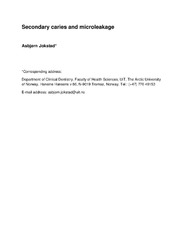| dc.contributor.author | Jokstad, Asbjørn | |
| dc.date.accessioned | 2016-03-02T15:39:23Z | |
| dc.date.available | 2016-03-02T15:39:23Z | |
| dc.date.issued | 2015-09-28 | |
| dc.description.abstract | Objectives: To critically appraise experimental ex vivo research that has focused on secondary caries, and to offer possible explanations for the seemingly poor correlation to clinical observations.
<p>Methods: The literature relating to the etiopathogenesis or prevention of secondary caries gained from experimental ex vivo research was reviewed, with particular emphasis on microleakage and artificial caries-like lesions.
<p>Results: It is doubtful whether a caries wall lesion can exist independently of an outer enamel caries lesion. Microleakage experiments apparently continue to emerge regardless of multiple reviews questioning the reliability and validity of the method. Several of the approaches used to generate artificial caries-like lesions are very aggressive. Remarkably little discussion has evolved about how these aggressive approaches create microenvironments that do not occur in reality. Corrosion- and biodegradation products may influence the biofilm qualitatively and quantitatively and it is difficult to replicate these variables in any ex vivo environment. Clinical data sampling method, patient demography as well as study methodology influences the incidence and prevalence estimates of secondary caries. Clinical results based on clinical work in settings where cost per unit time is of nominal concern do not provide any indications on how the restorative material will perform when placed by the average dentists in the mouths of their spectrum of patients during a busy workday.
<p>Significance and recommendations: The term “wall lesion” including its variants is ill defined, has been, and is still being used indiscriminately. Stakeholders should avoid using this ambiguous label due to its connotation to an entity that does not exist per se. | en_US |
| dc.description | Accepted manuscript version. Published version at <a href=http://dx.doi.org/10.1016/j.dental.2015.09.006>http://dx.doi.org/10.1016/j.dental.2015.09.006</a>. License according to the journal's policy on post-prints - CC-BY-NC-ND. | en_US |
| dc.identifier.citation | Dental Materials 2015, 32(1):11-25 | en_US |
| dc.identifier.cristinID | FRIDAID 1289537 | |
| dc.identifier.doi | 10.1016/j.dental.2015.09.006 | |
| dc.identifier.issn | 1879-0097 | |
| dc.identifier.uri | https://hdl.handle.net/10037/8624 | |
| dc.identifier.urn | URN:NBN:no-uit_munin_8193 | |
| dc.language.iso | eng | en_US |
| dc.publisher | Elsevier | en_US |
| dc.relation.uri | http://ac.els-cdn.com/S0109564115004029/1-s2.0-S0109564115004029-main.pdf?_tid=5c27e38c-8c57-11e5-b606-00000aab0f6c&acdnat=1447674434_c2fc1a29a091bd3f8ceeea47eb250453 | en_US |
| dc.rights.accessRights | openAccess | |
| dc.subject | Biofilms | en_US |
| dc.subject | Corrosion | en_US |
| dc.subject | Dental Caries | en_US |
| dc.subject | Dental Materials | en_US |
| dc.subject | VDP::Medical disciplines: 700::Clinical dentistry disciplines: 830::Preservative dental care: 831 | en_US |
| dc.subject | VDP::Medisinske Fag: 700::Klinisk odontologiske fag: 830::Konserverende tannpleie: 831 | en_US |
| dc.title | Secondary caries and microleakage | en_US |
| dc.type | Journal article | en_US |
| dc.type | Tidsskriftartikkel | en_US |
| dc.type | Peer reviewed | en_US |


 English
English norsk
norsk